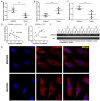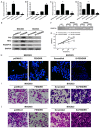The FENDRR/miR-214-3P/TET2 axis affects cell malignant activity via RASSF1A methylation in gastric cancer
- PMID: 30416662
- PMCID: PMC6220211
The FENDRR/miR-214-3P/TET2 axis affects cell malignant activity via RASSF1A methylation in gastric cancer
Abstract
To explore the effect of fetal-lethal non-coding developmental regulatory RNA (FENDRR) in the initiation and progression of gastric cancer (GC). We detected the levels of FENDRR, microRNA-214-3p (miR-214-3p), and ten-eleven-translocation (TET2) in GC tissues and GC cell lines. In addition, we evaluated the location of FENDRR in GC cell lines by fluorescence in situ hybridization (FISH). Cell proliferation and apoptosis were measured by CCK-8 and Hoechst staining assays. Methylation-specific PCR assay (MSP) was used to evaluate the methylation status of ras-association domain family 1A (RASSF1A). We also observed the direct binding of miR-214-3p on FENDRR by dual-luciferase activity assay in GC cells. FENDRR and TET2 expressions were significantly down-regulated and miR-214-3p was up-regulated in gastric cancer tissues compared to adjacent unaffected tissues. In addition, RASSF1A was hypermethylated in gastric cancer tissues compared to adjacent tissues. The expressions of all the three indicators were influenced by differentiation of tumor, TNM stage of tumors, and lymph node metastasis in patients with GC. A gastric cancer cell line with low FENDRR expression compared to a high FENDRR expressing cell line showed again increased miR-214-3p expression, decreased TET2 and RASSF1A expressions, and RASSF1A hypermethylation, resulting in decreased apoptosis and increased proliferation. Furthermore, we observed a negative correlation between FENDRR and miR-214-3p in GC. The FENDRR/miR-214-3P/TET2 axis plays a critical role in GC progress via methylation of RASSF1A.
Keywords: FENDRR; RASSF1A; TET2; gastric cancer; methylation; miR-214-3p; proliferation.
Conflict of interest statement
None.
Figures




References
-
- Suh YS, Yang HK. Screening and early detection of gastric cancer: east versus west. Surg Clin North Am. 2015;95:1053–1066. - PubMed
LinkOut - more resources
Full Text Sources
Research Materials
Miscellaneous
